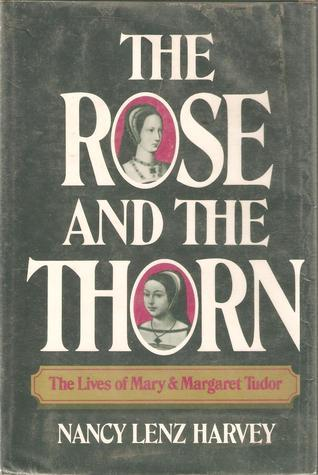The Rose and the Thorn: The Lives of Mary and Margaret Tudor by Nancy Lenz Harvey
Summary (from the publisher): The dramatic, extravagant, always fascinating lives of Mary and Marget Tudor - sisters and queens of the Renaissance, pawns in the power struggle for English supremacy - are here vividly recreated through their hitherto unpublished letters to each other and to their brother Henry VIII and through contemporary accounts - eyewitness reports, folk songs, and court poetry. These, skillfully interwoven with the narrative, reveal the whims, excesses, and hasty schemes that caused Queen Mary to lose France and Queen Margaret to lose Scotland, and impart to the story of the Tudor sisters an immediacy that no conventional historical recounting could ever provide.
At eighteen, Mary, "the most beautiful woman of her time," was married to the ailing Louis XII of France. Louis doted on his witty and lighthearted young bride, but he died eighty-two days following the wedding. Suddenly alone and surrounded by members of the French court she neither knew nor trusted, Mary seduced her brother's best friend, the Duke of Suffolk, into a secret marriage, explaining why she did so in her letters to Henry. Her letters to him also show how, through endearing sentiments and guile, she was able to get back into his good graces.
As for Margaret - short, stout, and plain - she was married at the age of twelve to King James IV to seal the peace between a warring England and Scotland. But the wars continued, and after James was slaughtered by the English in the Battle of Flodden Field, Margaret's reign as a Scottish queen of English descent was constantly challenged by rival Scottish chieftains. Her brother ignored her repeated pleas for help and in desperation she subsequently entered into two reckless marriages - the first to Archibald Douglas, Earl of Angus; the second to Henry Stewart, Lord Methven. Both marriages degenerated into a struggle for power that Margaret was ill-equipped to fight, and she lost it all - power, love, and finally her infant son. Alienated from her brother, her friends, and her subjects, she reveals in her letters her bitterness and confusion as she sinks further into solitary despair.
The opulence and splendor, the private passions of the power-wielders, and the public pageantry of the sixteenth century are dramatically presented in The Rose and the Thorn. The author has woven a rich tapestry that vividly brings to life the personalities who altered history and have thus affected the lives of us all.
Review: Born princesses to Henry VII and his queen Elizabeth of York, Margaret and Mary Tudor are mostly remembered today as the sisters of King Henry VIII. Mary was married off to the elderly and ailing King Louis XII and then earned her brother's wrath when she married her brother's best friend, the Duke of Suffolk, after King Louis's death. And Margaret was married off to the King of Scotland and after his premature death entered into not one but two impetuous and ill-advised marriages.
I enjoyed this dual biography of the sisters, although their age difference and marriages to Kings in different countries meant their lives overlapped very little. Harvey is particularly harsh on Margaret, describing her thus: "She had innate intelligence which she never disciplined. She had power which she never controlled. And she had ability that she rarely exercised. She was from birth the pampered princess of the English court" (4). Margaret was particularly close to her brother Prince Arthur and it is curious to imagine what her life would have been like had he not died and instead become king as he was born to be.
Margaret's life is more interesting in some ways because it is through her that he current royal family descends. "A hundred years later the great-grandson of James Stewart and Margaret Tudor rode south to London as James VI of Scotland to become James I of England and to unite forever the two thrones under a single rule" (33).
Meanwhile, Mary was a great favorite of her brother Henry. Despite angering her brother by marrying the Duke of Suffolk after the King of France's death, Mary seems to have gotten the better deal. Aside from money troubles related to her required royal lifestyle, she and the Duke of Suffolk seem to have had a happy life in England, occasionally visiting her brother at court but enjoying a tranquil country lifestyle. She was a close friend of Henry's wife Catherine of Aragon, so it was little wonder that her final years were mired by displeasure over her brother's public efforts to divorce his wife to marry his mistress, Anne Boleyn.
History remembers the wives of Henry VIII much more vividly than they do his sisters. But it was his sisters who were truly more constant, lifelong companions and correspondents than any other woman in his life. And it was through his sister Margaret that Henry's line continued after the failure of his own children to reproduce. I do feel like this biography could have been longer and skipped over some details, such as the many affairs of Margaret's husband and the lives of Mary's children, but it was a nice overview and snapshot of their lives, and I appreciated that they featured so much text from their actual letters written to their brother during their lifetime.
Stars: 4
Related Titles:
- Mary Boleyn: Mistress of Kings by Alison Weir
- The Children of Henry VIII by Alison Weir
- The Six Wives of Henry VIII by Alison Weir
- Catherine of Aragon: The Spanish Queen of Henry VIII by Giles Tremlett
- Tudor: The Family Story by Leanda deLisle
- Elizabeth of York: A Tudor Queen and Her World by Alison Weir



Comments
Post a Comment